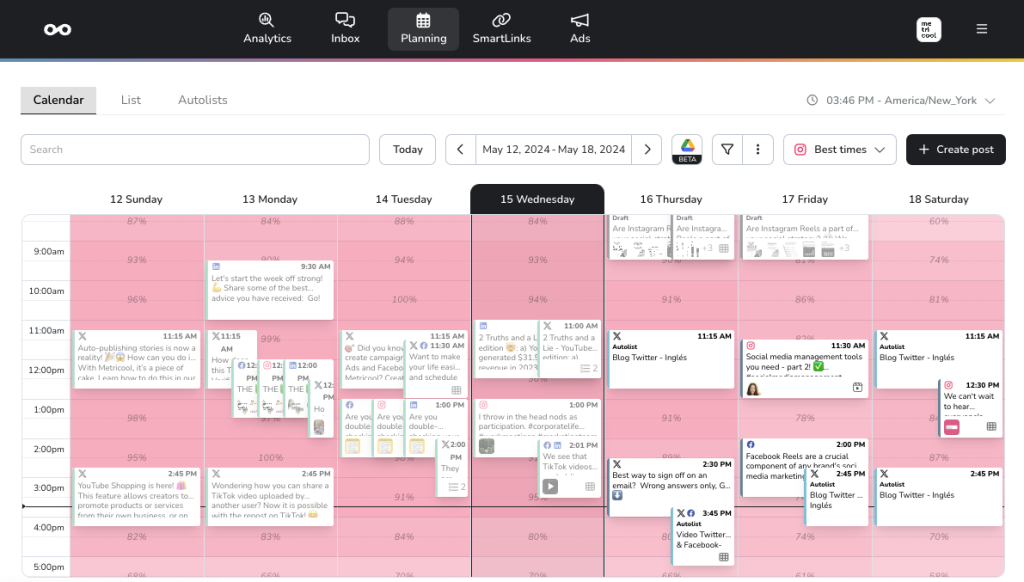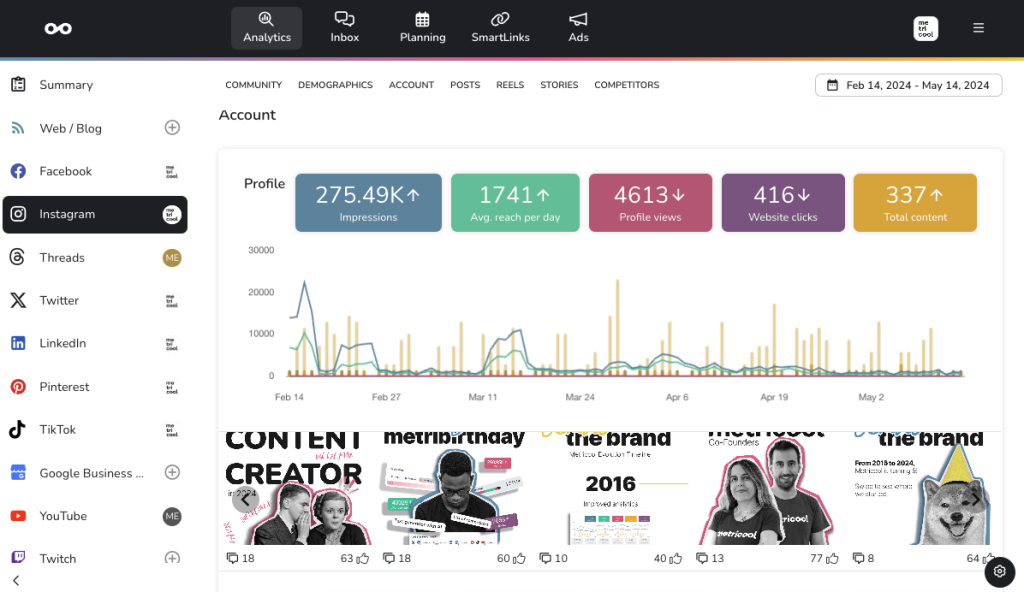2025 Guide to Inbound Marketing

In marketing, there are two strategies for reaching potential customers and leads: inbound and outbound. Today’s digital era is flooded with options, content, and promotions at every click. Before investing in a product or service, users want to feel powerful in their buying choices. Therefore, inbound marketing is often preferred over outbound marketing.
As you will find in this article, inbound marketing is an organic way to bring customers to your product or service via quality content, resources, or information. This process generates quality leads and allows users to find what they seek.
What is Inbound Marketing?
Inbound marketing, or inbound strategy, is a methodology that allows you to attract customers using non-intrusive digital marketing and advertising techniques such as:
✅ Implementing SEO strategies (Search Engine Optimization).
✅ Creating quality content that relates to your ideal client.
✅ Posting on social media to promote your brand.
✅ Analyzing your content and comparing it against your strategy.
A successful inbound marketing strategy depends on combining these techniques, and ensuring they are implemented and utilized consistently.
Inbound marketing’s main purpose is to reach users at the beginning of the purchase process and accompany them until the final transaction, turning them into loyal customers.
Inbound vs. Outbound Marketing
Outbound marketing focuses on getting in front of customers through traditional tactics – cold calling and emailing, TV and radio ads, press releases, trade shows, seminars, etc.
While this places your brand in the forefront of someone’s mind, it can also be an intrusive way to market your products or services if done improperly. People do not want to be told what to buy, but rather what solutions or problems your product can solve if they buy it.
Inbound marketing puts the customer first, allowing them to organically reach your brand through search results, blog content, social media posts, newsletters, YouTube videos, etc. You can foster customers to create mutually beneficial relationships where their needs are met, and you win a quality customer.
To see the differences between these two strategies in depth, make sure to read this article:
Benefits of Inbound Marketing
Inbound marketing moves away from traditional marketing strategies that rely on direct outreach. Rather, customers can find brands through organic searches, related content, social media, and blogs, just to name a few examples.
Quality lead generation
One of the first benefits of using inbound marketing is opening the gates to lead generation. While you optimize your content to target your ideal audience, this will help generate more quality leads that are more likely to invest in your brand.
You can generate leads through multiple sources by implementing inbound strategies across all your channels.
Increase website traffic
Improving your website’s pages and blog posts can boost your rankings in search results, thus getting your content in front of more users. How can you do this? Through keyword research, you can see which topics are trending and what issues your ideal audience is having.
Then you can create content that helps address these issues, and let your brand be the solution. If you can do this, users are more likely to head to your website to find further resources, convert into users, or purchase.
Gain authority and credibility
Rather than forcing messages in front of your audience, users can organically find your content. This allows users to research and explore all options before purchasing, rather than feeling pressured by a brand to buy something. If you provide quality resources and solutions, this will help raise credibility among your ideal clients.
Word-of-mouth marketing is still alive, so if customers rave about your brand’s resources and support, this can further benefit a business.
Save costs
Opposite to traditional marketing and advertising, inbound marketing cuts costs tremendously. Rather than putting all your efforts into expensive campaigns, save money utilizing organic strategies. Creating evergreen content perpetuates your content’s longevity, allowing you to continue gaining leads on older and newer content. Over time, you can audit your profiles and content to stay fresh, without reinventing the wheel.
Inbound marketing aims to attract customers and create a positive user experience, encompassing each stage of the buying experience – from the moment a potential client becomes aware of your brand, through the purchasing process, and even afterward to continue building loyal customer relationships.
These are the four fundamental stages in an inbound strategy:
💡Attract, Convert, Nurture, Satisfy
1. Attract
This first phase aims to increase traffic and attract potential clients. For this stage, marketing techniques such as SEO and social media promotion help cross-promote your brand across multiple channels.
💡 METRI TIP: We suggest creating editorial calendars for your social media content and blog, to stay on track with content distribution, and to brainstorm new ideas.
In these calendars, you can track trending keywords related to your ideal clients, so you can turn around and make content addressing these topics.
2. Convert
As you continue to create and post quality content, the next step is to convert these visitors into leads. To do this, carry out more personalized techniques – emailing, setting up a meeting, responding via DMs, etc.
Make sure it is easy for users to find your contact information if needed. Then when you come in contact with a potential user, you can answer their questions, direct them to further resources, or explain more about your brand. Be present and active on your channels during this stage.
3. Nurture
After the conversation has been initiated, you need to continue “nurturing” this lead in the hope that they convert into a paying customer.
✳️ Lead nurturing engages visitors who have interacted with your brand, converting them into customers. This can include offering limited promotions, special announcements and releases, and further support depending on their needs.
Respect potential clients’ space and avoid bombarding them with information or messages for a negative experience with your brand.
4. Satisfy
The last stage of inbound marketing takes place after a customer has converted. The objective of this last phase is for customers to feel satisfied with their purchase, and to continue being loyal customers. To do this you can:
- Conduct email marketing campaigns
- Send special client offers
- Invite customers to live events
- Offer customer support
- Ask customers for feedback
These strategies can help perpetuate a mutually beneficial relationship, where your brand can support the customer while they continue to support your business. Listening to your client’s feedback, criticisms, and praises will help you understand what you need to do to continue building lasting customer relationships.
Elements of an Inbound Marketing Strategy
Once you start to build your inbound marketing strategy, there are a few elements to keep in mind so that you can maximize your efforts and see results:
Brand website
Most importantly, your inbound marketing strategy should rely on your brand website.
Within the website, it is important to have a blog. There are many channels through which inbound marketing can be done, but a blog is one of the most powerful channels to scale. Blog content can add value to users and for many, can be a pivotal element in boosting conversions.
When it comes to optimizing your website, consider the following:
⏩ Design
This is the first thing to catch a potential client’s attention, so ensure your website reflects your brand image and voice.
⚠️ In addition to having an attractive design, your website must be adaptable to any mobile device, tablet, or computer to be accessible by any user.
⏩ User-oriented
Neuromarketing will also attest that design is key to convincing your users to take action. The more motivation and less complexity, the easier it will be for your client to make a purchase, a subscription, or any other action.
Make your website easy to navigate, and tell your brand story throughout your website so users can connect with your brand on a deeper level.
⏩ Programming
In terms of programming, think about your reaction when you click on a link and the web does not respond, it takes time to load or gives an error.
You will not visit that website again and will look for another, right?
💡 Conclusion: pay special attention also to the technical part and its navigation errors.
Automation
Automation can help deliver instant responses, emails, or communications to customers. This will save you time and allow you to adjust based on the client’s needs. Although this process helps you in the lead nurturing phase, create more personalized and targeted messages after a conversion. Automating processes can save time in your social media creation and scheduling process.
Below you can learn how to utilize social media marketing automation tools to speed up your processes and optimize your workflows:
Content Marketing
Another key aspect of inbound marketing is what content you create. This strategy aims to create content that addresses user’s needs and send it to them through their preferred channel – email, social networks, apps, etc. To understand your ideal clients, you need to ask yourself:
- What do they need?
- Where do they consume content?
- What issues or problems are they facing?
This knowledge will guide the product and editorial teams in the same direction, to find the information that the user demands. We recommend creating your ideal client’s “buyer personas” to describe how users behave online, what content they consume, and which channels they use.
This analysis will lead you to create a content plan for your ideal client with which you will guide them through the funnel until you get the action you want. We also recommend building a strong content marketing strategy to align your content with your business goals.
Analysis
An inbound marketing strategy lacking analyses sets your brand up for failure. Thanks to the internet’s expansive information collection, we can track a huge amount of data to observe successes and shortcomings.
Before you get overwhelmed with the numbers and data, it’s crucial to sit down and figure out what goals you want to achieve, and which metrics will help measure these objectives. Then, it’s time to analyze. Want to skip manual data collection as a whole?
Metricool’s social media analytics dashboard allows you to view data about your website or blog’s performance, and all connected social media channels, allowing you to frequently analyze data and ensure your strategy is on track.
Execute your Inbound Marketing Strategy with Metricool
With Metricool, schedule and auto-publish content across multiple channels simultaneously, with our social media planner. Connect to over nine social media channels and advertising platforms to centralize social media management. You can also access our best times feature to see the best times to post for your audience.

As mentioned above, view in-depth data about how your content is performing. Then, create custom social media reports to automate monthly and send to clients. View your top-performing posts to review what has worked well, and what needs improvement.

Create your FREE account (for life) and level up your social media game. 👾

